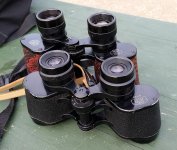Do I have this about right, and can anyone offer further technical explanation? Or is it the case that high-ER designs actually wind up limiting the real FOV, and thus the apparent as well?
Hi Tenex, I try to answer. As you know, the field of view is determined by the optical scheme of the eyepiece and its field diaphragm.
The visible field is generally chosen by the designer, also based on the distance of the pupil extracted from that optical scheme.
Some choices will be better or easier than others, as optical geometry allows it. For example, this is the case with old designs, but unsuitable for glasses.
The geometric rendering of the eyepiece is very responsible for the three-dimensional sensation (immersion in the scene, perceived distortion, crushing of the planes in the depth, etc.). And the new productions of short binoculars (with short focal length) with a wide and flattened field, require short eyepieces from which to obtain long pupillary extractions (more ideal for glasses).
This makes it difficult to draw good eyepieces, so many results deform the final geometries and degrade the three-dimensional rendering.
The new Swarovski EL are examples of reference as regards the wide flattened field, without distortion and sharp to the edge, which maintains a good three-dimensional geometry. With the only defect of producing the globe effect.
A curved field will always be narrower than the same flat field.
And this is not why the trigonometric formula used in optical physics and therefore also in ISO standards, delivers a "slightly lower" value. Trigonometry is a mathematical function that does not produce errors: 2 + 2 = 4 always and in any case, regardless of the mentality or personal opinion of some people.
The field diaphragm of the eyepiece determines and borders what can be seen in the binoculars. If I can see a 140m field (420ft / 1000yd or 8 °), I will see 140m field from a distance of 1'000m, regardless of distortion, curvature, astigmatism or any other useless inference.
The edges of the observation window of that binoculars are drawn by the field diaphragm and the window will have an apparent amplitude calculable only with the trigonometric formula (ISO).
Thus, 140m in binoculars 10x = 70 °, while 140m in 8x = 58 °, etc.
The improper gesture of multiplying the amplitude of the angular field by the magnification is a completely incorrect procedure that only leads to incorrect results (even a lot).
What you need to measure is the width of the observation window that you see inside your binoculars and compare it with what you see with the naked eye. Place the binoculars on a tripod at a distance of 10cm (4 ") from the wall, so that the optical axis is orthogonal. Now, with your right eye look inside the left eyepiece and with your left eye check the wall size of the binoculars window, marking the vertical dimension (the diameter). Then measure the precise distance between the wall and the pupil extracted from the eyepiece and do the trigonometric calculation, with the values of the diameter and the distance. The result you get is that real of your instrument and that you can compare with other binoculars.
If you don't know how to do the calculation, give me the measurements you found, which I will calculate for you.






